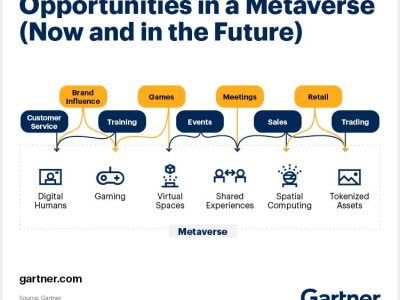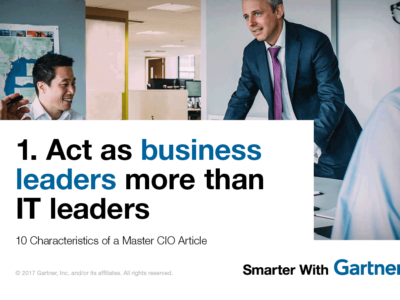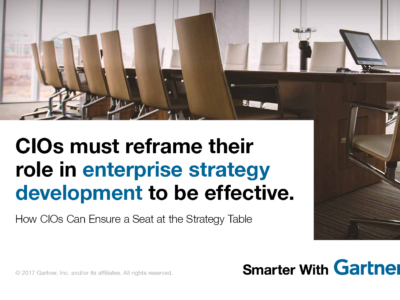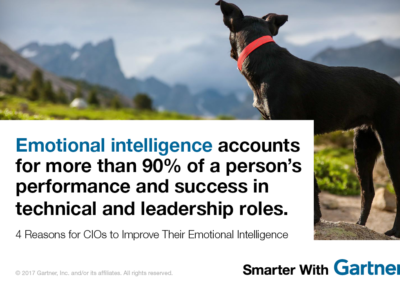How UPS leverages an innovative mindset and technology to optimize delivery and customer experience.
The last time you ordered a product online, chances are you paid attention to the price first. Then you immediately checked the delivery date. Tracking their packages has become so essential to customers, that United Parcel Service (UPS), a U.S.-based multinational package delivery company, has made innovating the personal supply chain one of its chief goals.
“If you want to innovate, it’s important to be close to what you do”
Juan Perez, UPS Chief Information & Engineering Officer, leads the technology teams responsible for helping the company reach such goals. This mandate underscores the importance of fostering an innovative mindset, explained Perez during his CIO Story session at Gartner Symposium/ITxpo in Orlando, Florida.
“How do you personally and within your organization, drive innovation?” he charged the audience of CIOs and IT leaders. At UPS, that may mean taking a stint as driver of one of their ubiquitous brown trucks. Executives and other staff rotate as drivers to understand the full delivery experience. “If you want to innovate, it’s important to be close to what you do,” Perez said.
Optimizing this physical delivery system with technology will enable the company to keep pace with explosive growth in online retail sales. “Today we think of ourselves as a technology company and not just a small package or freight company,” Perez said. “We are very actively changing that mindset. We need to constantly communicate it to the world in order to get the best talent.”
Technology in action
When thinking of technology innovation, Perez shared three UPS strategies that initiate the process and drive business growth.
Enhanced mobility
Mobility is changing the way UPS and every other company conduct business today. As an example, Perez talked about the evolution of a driver’s handheld device, known as the Delivery Information Acquisition Device or DIAD. In the 1990s, drivers were given a clipboard-sized DIAD to aid in deliveries. Since the first device, the company has developed new iterations to improve usability and efficiency.
The company is developing the next version now. The updated version will be easier to use and will provide more insight to customers, the driver, and the company. “Customers are demanding more visibility than ever,” said Perez. The new devices will be “a complete transformation in the way we will do business in supporting our customers.”
Empowered consumers
The company’s technology innovation has kept pace with a new generation of empowered customers. Previously, UPS considered the shipper of a package as its primary customer. Today it focuses attention also on the package recipient. “[Technology is] forcing companies like us to continue to adjust to what our customers are looking for,” Perez said.
Today’s customers require more convenience, choice, and control. In an effort to provide flexible channels to customers on their own terms, UPS developed UPS My Choice, a service that gives consumers more control over their residential deliveries. The online platform allows customers to manage what Perez calls, ‘their personal supply chains,’ by receiving alerts and controlling delivery. UPS My Choice now has more than 40 million subscribers in 15 countries. Interestingly, UPS saw an increase in subscriptions timed with Apple product releases that Perez attributes to customers wanting to know the status of their shipment.
Evolving technologies
UPS is also utilizing emerging technology to help solve operational problems. “My job is to continue to find ways to enable innovation across companies to utilize emerging technologies,” Perez said.
In the area of artificial intelligence (AI), UPS has leveraged ‘chatbots,’ a computer program that conducts conversations online, to communicate and resolve issues with customers. Using virtual reality (VR) applications, UPS trains new drivers how to spot and identify road hazards on their routes. UPS also is exploring how drones can be used for humanitarian aid and urgent time-sensitive delivery to hard-to-reach locations.
Data that saves time and money
“Data continues to be the most important evolving technology for UPS,” said Perez. Through powerful data, technology, and innovative engineering, UPS created ORION (On-Road Integrated Optimization and Navigation), a platform that optimizes drivers’ delivery routes.
For a UPS driver in the U.S., the average delivery route has 100 stops. Initial results show miles reduced with each route using ORION. A reduction of just one mile per driver per day over one year can save UPS up to $50 million.
UPS continues to improve functionality and impact of the tool. The next version of ORION will allow for dynamic route optimization that will take traffic, customer delivery requests, and other obstacles into consideration in real time to aid the driver so he or she can deliver on time and in the least amount of miles.
Get Smarter
CIO Futures: The IT Organization in 2030
The IT domain in 2030 will evolve out of today’s agile practices and professional services models. CIOs will organize a fluid arrangement…
The Art of the 1-Page Strategy
Strategic planning is at the heart of any enterprise, and alignment with the corporate strategic plan is often a key concern of CIOs….










